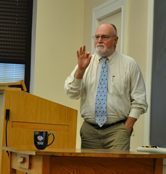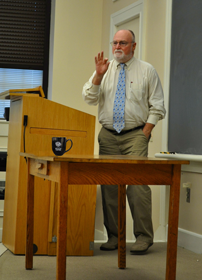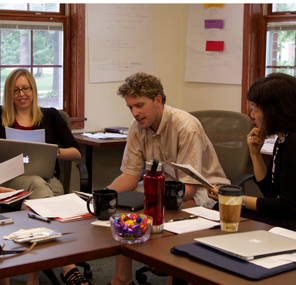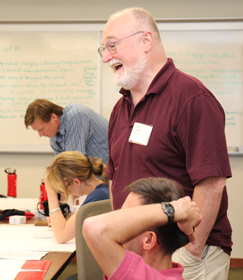
On Not Lecturing
When I started teaching I relied, like many others, on the examples of my own teachers. When I was an undergraduate, the teachers who moved me most were never straight lecturers. So, I tried to adapt their styles. The more I taught and especially the more I engaged with the literature about teaching and learning in the middle of my career, the more I developed an array of teaching strategies that depended upon student contributions to class sessions. As I continue to move in that direction, several things continue to surprise me.
- Listening becomes your most essential skill . . .,
- followed closely by the ability to keep your own mouth shut, at least some of the time (see Donald Finkel, Teaching with Your Mouth Shut [Portsmouth, NH: Boynton/Cook, 2000]).
- While it may seem like you are giving up your ability to set the agenda for class sessions, limiting the time you lecture actually switches the arena for agenda setting (see Stephen Brookfield and Stephen Preskill, Discussion as a Way of Teaching [San Francisco: Jossey-Bass, 2000, 2nd ed.).
- If anything, designing contexts for learning becomes more important when lectures aren’t the dominant mode of instruction (see L. Dee Fink, Designing Significant Learning Experiences [San Francisco: Jossey-Bass, 2003]).
- Assigning readings or other activities, posing questions to be considered, and various other activities can give shape and direction to the class session beforehand.
- When student contributions make up the bulk of a class session, making connections becomes one of your most important contributions.
- Ordering, juxtaposing, and otherwise relating student comments to each other is like making art, or at least sense, with found objects. It demands both discipline and creativity—and it can be fun.
- Mini lectures can still be an important part of a class session. They can summarize, make transitions, introduce new, related topics, and provide necessary background.
- “Coverage” begins to appear in a new light—where the mastery of facts takes a back seat to the demonstration of understanding through making statements, asking questions, venturing comparisons and other processes.
- Forms of evaluation or assessment need to be aligned with what actually goes on in the classroom. The work done in class sessions needs to be connected to the work done on higher stakes assignments.
- You never quite know what will happen . . .
- and that gives everyone an incentive to come to class, ready to work.
“Watch Gene’s decidedly untechnological TEDx talk on Millennialism”
Editor’s Note: Join us every Tuesday and Friday over the next two months as we explore more ways that we can achieve our teaching goals more effectively when lecturing less.



Gene, why can’t I be you?
Thanks for the thoughtful post. You referenced Finkel’s Teaching With Your Mouth Shut. It is a great book, and your blog reminded me that I probably need to read it again!
I find in my own experience that teaching this way is, as you imply in #11 and #12, fun because it differs so much every day and every time you teach the class. I also agree, as you say in #4 and #5, that it takes a lot of prep work that doesn’t really diminish when you reteach the class, unlike writing a lecture once and then reusing it.
I sometimes wonder about burnout for those who use discussion-based, experiential, or other non-lecture approaches in most of their courses over most of their careers. As someone who has been teaching “since the early bronze age,” what do you think?
My two cents is that it definitely takes more effort and time to get ready to teach in non-traditional ways. But I try to do a variety – lecture, group discussions, creativity exercises, student teaching, group projects, etc. It allows the pressure/time consumption to be more balanced.
Kate: not advisable. Stay you.
John: it’s one of a handful that I keep going back to. He had some luxuries of time at his institution that aren’t available to everyone else (e. g. meeting class for another afternoon session on the spur of the moment), but there is lots of stuff that is adaptable. It would be cool to hear from others what few books or articles on teaching that they find themselves frequently going back to.
Thanks, Ben. I actually think that the newness of teaching in the way that you describe has two (at least) intriguing dimensions. One it can be terrifying not to know what will happen. But, then, fear concentrates the mind. I first tried a small move like what I describe when I was still a grad student and teaching my first course by myself. The students were dutiful, but I feared I wasn’t really listening to them. I broke up a primary text into one chunk per student and let them have their say in turn before I said a thing. All the while I was (I hope not visibly) sweating bullets. So, I was simultaneously terrified and invigorated. It worked, so I got bolder, or loonier, as I went on teaching over the years.
So, I find that the newness (and the terror) outweigh any chance of burnout. Just when I think I know how something will go in the classroom, based on past experience, something unanticipated happens that puts everything in a different light. It makes me think, and helps me make them think. So, rather than burning me out, it fires me up.
It can get exhausting, though. But it is, after all, work, and very honorable work at that.
I think your are right, Karen. What I like now about having taught for a while is that I think that I have a lot of instructional options. As you say, they can be mixed and matched, and you can choose one for a variety of reasons, including what you need at the time and what you perceive your students to need at the time. Taking care of what you, as the teacher need, is a way to avoid burnout and save yourself for continuing interaction with the students. Personally, my involvement with Wabash has increased my teaching repertoire enormously. I endorse the motto, “steal (teaching ideas) shamelessly.” I love it that the Wabash Center fosters the conviction that we are all in this together.
Steal shamelessly is my teaching motto, too. We are all in this together which makes this series even more important.
Thanks for this post. I moved to this style of teaching some time ago, and I find that my students tend to leave with a more comprehensive grasp of the subject matter by the end of the course. Interestingly, over the years the challenge for me in doing this style of teaching is the institution’s teaching and learning culture–lecturing is still the normative expectation for structuring class time and scheduling classes. Also, you don’t mention whether or not the time frame for a class makes this way of teaching more viable. I find that a 3-hour block once a week works better than a 90-minute class twice a week. Thanks again for your post.
Thanks, Marcia. I think that time frame is very important. But there may also be a bit of personal taste involved. I find that I work better in our twice-a-week 75 minute classes than I do in the whole, long three-hour block. I find that the students tend to fade in the second half of those classes. But you are definitely right that the style/activity/presentation/whatever needs to be carefully tailored to the time available. We also need to make a sober assessment of how much of the “time available” is actually available for teaching and learning, as opposed to shuffling around getting ready, handing stuff out, etc. etc.
I always try to have about three hours of stuff that I am thinking of doing for each hour of actual class time. That gives me multiple options as things unfold.
One of my small frustrations with Finkel’s book is that it doesn’t acknowledge the different sorts of time periods into which courses are crammed.
Rob Muthiah said:
Thanks for these ideas, Eugene! I am particularly stimulated by #6 — a big part of our role in a setting the de-emphasizes lectures is making connections. I think sometimes I sit back a bit too much in relation to this — I make connections in my head while students are discussing things, but I think I need to do a better job of sharing those thoughts with the class as a way of offering my training/experience to the learning community.
Thanks Dr. Gallagher for your insights into your successful pedagogy. In reading your teaching methodology, I am reminded of “flipped classrooms” (e.g., http://www.knewton.com/flipped-classroom/ and http://net.educause.edu/ir/library/pdf/eli7081.pdf). This approach to the educational process is both intense and educationally rewarding for both students and teachers. It also demands that students do the necessary preparatory work for intelligent discussion so that their own responses /claims are based on substantial evidence.
For me, I am not “there” just yet and dynamic teachers like Dr. Gallagher continually challenge me. I realize I probably talk too much and control the movement of the class in attempt to get through my class outline for a given period. However, I believe that I also am realistic in that I know that maybe half the class has not done the assigned reading – at least not a “close” analysis of the required text(s). Regularly strategizing w/ students and faculty colleagues as well as efforts like this Wabash blog help me regularly to think through my teaching and how to optimize the classroom for even greater engaging educational enterprises. Thank you.
Posted by: Patrick Flanagan | 09/24/2013 at 01:29 PM
Thanks, Rob. Making connections in a dynamic discussion-oriented classroom can feel like working without a net. Since we can’t predict what will be said beforehand, we don’t know what direction the discussion will take. I favor pretty old-school techniques for keeping track of things. I try to write (very) simplified versions of comments on the board and then take some time, periodically, to draw (literally) some potential connections and text them out with the rest of the group.
Posted by: Gene Gallagher | 09/24/2013 at 02:13 PM
Patrick: my fundamental question about class time is what can happen there that cannot happen in any other setting, either students alone, or in the library, or online, or even talking with each other without my involvement. What am I bringing to the party? One thing is precisely that sense of control. We probably need a richer vocabulary for all types of non-coercive forms of control, e. g. steering, gently guiding, etc. etc. I typically go into a class session with one, two, or maybe three things that I want use to get all I can out of it. How we get there is then totally up for grabs once the conversation starts. But I trust teachers of all stripes to be able to see connections and further questions that not all students can. I think more and more that winnowing goals for a class session down to an achievable very few is the way to go. Then the attention shifts to designing contexts and stuff to do (aka “activities”) that might make move everyone in that direction. the next design challenge is linking one class to another, to another . . .
Posted by: Gene Gallagher | 09/24/2013 at 02:19 PM
Thanks Gene. Great suggestions! Having tried to create more engaged discussion based classes, I have found that there are still some students that somehow think they are not getting their “money’s worth” out of peer discussions and that I should be lecturing (for 3 whole hours – ugh!). I’ve even had them stand up and leave when I use small group discussion or dyads (usually when they have the anonymity of fairly large classes).
Any suggestions of how we might persuade them otherwise (e.g., make them read Finkle) or do we just plug away and try to pull them along.
R.
So refreshing to encounter someone who uses the same language I do (it’s not about “coverage”), who reads the same books (Brookfield, Finkel), who finds the same refreshment in teaching this way. Thank you, Gene!
Hi Richard. I don’t know if they are ready to read Finkel, but brief and moderately frequent discussions about why we are all in the classroom might be helpful. I’ve become more and more convinced that I need to relate whatever is going on in the classroom to things with which they are somehow familiar. Whether it is incidents from their own lives, things that they’ve picked up from news and entertainment media (much more the latter usually) or any other sources, I keep trying to indicate how what we do in the classroom is actually “news you can use” rather than — cue the pejorative — something merely “academic.” I tell them frequently that being in a liberal arts institution is like being in the map at the mall– where the red dot says “you are here.” What I am trying to do is to get them to see their own here and now in the contexts provided multiple “theres,” i. e. other cultures, and “thens,” i. e. other times. The effects that I hope for are the cultivation of a broader sense of possibilities, an understanding of the consequences of choices, and an understanding that things might be different.
All that said, I tend to do this stuff in very small bits throughout the term.
Laura: I love the term refreshment. It’s a lot of what lingers after the terror of not knowing precisely what will happen in a given class session is momentarily held in abeyance. Seriously listening to someone else can produce that sense of newness, or refreshment.
Gene,
How do you do this with a larger class, say 70 students?
Good question, Kirsten. That certainly makes it more challenging. I routinely team-teach a 60 student introductory class in the fall. I often do smaller exercises in which I put students into ad hoc groups, or assign each row a particular topic in a larger set of topics. Our intro is arranged around the general theme of religion and globalization, and has units on Xnty, Islam, Hunduism, and Rastafari. Tomorrow we finish the segment on Xnty and my primary text is the letter from the Anglican bishop of Uganda critiquing the American Anglican tolerance for same-sex relationships, etc. I’m planning on having a group try to capture the best reasons for the Ugandan position, a group working on an American Anglican response, and I may have a third group evaluating the cogency of each position. Just an example . . . It’s hard to be dialogical and fully inclusive with that many folks, but it’s still possible, I think, to invite all kinds of participation.